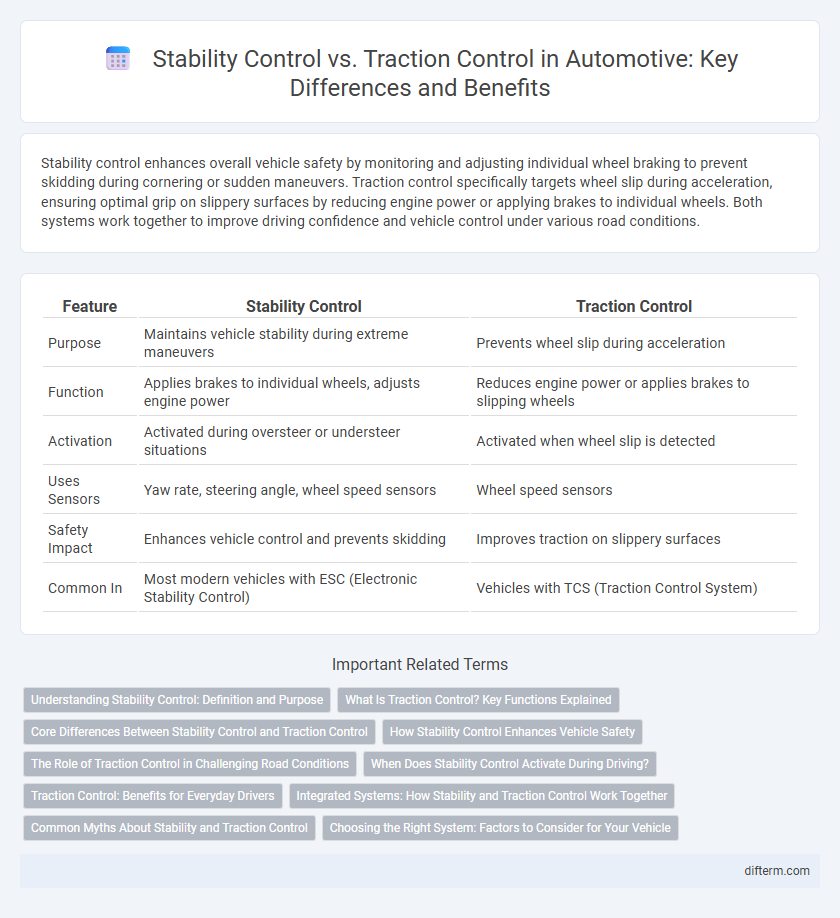Stability control enhances overall vehicle safety by monitoring and adjusting individual wheel braking to prevent skidding during cornering or sudden maneuvers. Traction control specifically targets wheel slip during acceleration, ensuring optimal grip on slippery surfaces by reducing engine power or applying brakes to individual wheels. Both systems work together to improve driving confidence and vehicle control under various road conditions.
Table of Comparison
| Feature | Stability Control | Traction Control |
|---|---|---|
| Purpose | Maintains vehicle stability during extreme maneuvers | Prevents wheel slip during acceleration |
| Function | Applies brakes to individual wheels, adjusts engine power | Reduces engine power or applies brakes to slipping wheels |
| Activation | Activated during oversteer or understeer situations | Activated when wheel slip is detected |
| Uses Sensors | Yaw rate, steering angle, wheel speed sensors | Wheel speed sensors |
| Safety Impact | Enhances vehicle control and prevents skidding | Improves traction on slippery surfaces |
| Common In | Most modern vehicles with ESC (Electronic Stability Control) | Vehicles with TCS (Traction Control System) |
Understanding Stability Control: Definition and Purpose
Stability control is an advanced automotive safety system designed to help drivers maintain vehicle control during sudden maneuvers or slippery conditions by automatically applying brakes to individual wheels. Its primary purpose is to prevent skidding and loss of control, reducing the risk of accidents caused by oversteer or understeer. Unlike traction control, which focuses on preventing wheel spin during acceleration, stability control ensures overall vehicle stability by monitoring steering input and vehicle dynamics.
What Is Traction Control? Key Functions Explained
Traction control is a vehicle safety system designed to prevent wheel slip during acceleration by automatically adjusting engine power and applying brakes to individual wheels. Its key functions include maintaining optimal grip on slippery or uneven surfaces, enhancing vehicle stability, and improving driver control during rapid acceleration or turns. Unlike stability control, which manages overall vehicle dynamics, traction control specifically targets wheel spin to ensure effective power delivery and prevent loss of traction.
Core Differences Between Stability Control and Traction Control
Stability control primarily manages vehicle direction by selectively braking individual wheels and adjusting engine power to prevent skidding during turns, while traction control focuses on minimizing wheel spin during acceleration on slippery surfaces by reducing engine torque or applying brakes to specific wheels. Stability control systems use sensors such as yaw rate and steering angle to detect loss of control, whereas traction control relies mainly on wheel speed sensors to identify slip. Both technologies enhance safety but target different driving conditions; stability control aids in cornering stability, and traction control ensures grip during acceleration.
How Stability Control Enhances Vehicle Safety
Stability control enhances vehicle safety by continuously monitoring steering input, wheel speed, and lateral acceleration to detect loss of control and automatically applying brakes to individual wheels, helping to maintain the intended path during sharp turns or slippery conditions. Unlike traction control, which primarily prevents wheel spin during acceleration, stability control actively intervenes to correct oversteer and understeer, significantly reducing the risk of skidding and rollover accidents. This advanced electronic stability program (ESP) technology is especially critical in emergency maneuvers, improving overall vehicle handling and driver confidence.
The Role of Traction Control in Challenging Road Conditions
Traction control enhances vehicle stability by preventing wheel spin during acceleration on slippery surfaces such as ice, snow, or wet roads. It works by modulating engine power and applying brake force to individual wheels, improving grip and maintaining directional control. This system is crucial for safe driving in adverse weather, reducing the risk of skidding and loss of control on challenging terrains.
When Does Stability Control Activate During Driving?
Stability control activates during driving when the vehicle detects a loss of directional control, such as during oversteer or understeer scenarios on slippery or uneven surfaces. It automatically applies braking to individual wheels and adjusts engine power to help maintain the intended driving path. This system works proactively to enhance vehicle stability especially during sharp turns, sudden maneuvers, or evasive actions.
Traction Control: Benefits for Everyday Drivers
Traction control enhances vehicle stability by preventing wheel slip during acceleration, especially on slippery or uneven surfaces. It improves safety by maintaining optimal grip, reducing the risk of skidding or loss of control in everyday driving conditions. This system is particularly beneficial in wet, icy, or gravel road scenarios, providing drivers with confidence and better handling performance.
Integrated Systems: How Stability and Traction Control Work Together
Integrated automotive systems combine stability control and traction control to enhance vehicle safety by simultaneously managing wheel slip and directional control. Stability control uses sensors to detect loss of steering control, applying brakes selectively to individual wheels to maintain the intended path. Traction control complements this by regulating engine power and braking to prevent wheel spin during acceleration, resulting in a cohesive system that improves handling across diverse driving conditions.
Common Myths About Stability and Traction Control
Common myths about stability and traction control include the misconception that these systems are interchangeable, when in fact stability control primarily prevents skidding during sharp turns by adjusting brake pressure, while traction control limits wheel spin during acceleration. Some drivers mistakenly believe that both systems make vehicles invincible in slippery conditions, but they only enhance safety by assisting driver control rather than replacing skill. Another widespread myth assumes these technologies are only beneficial on wet or icy roads, yet they also improve handling and stability on dry surfaces during sudden maneuvers.
Choosing the Right System: Factors to Consider for Your Vehicle
Choosing the right stability control or traction control system depends on your vehicle type, driving conditions, and safety priorities. Stability control enhances overall vehicle balance during cornering and sudden maneuvers, making it essential for SUVs and heavier vehicles prone to rollovers. Traction control focuses on maintaining grip during acceleration on slippery surfaces, ideal for performance cars and regions with frequent wet or icy roads.
stability control vs traction control Infographic

 difterm.com
difterm.com